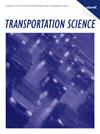具有任意节点分布的旅行推销员问题实例最佳行程长度的神经网络估算器
IF 4.8
2区 工程技术
Q1 OPERATIONS RESEARCH & MANAGEMENT SCIENCE
引用次数: 0
摘要
解决复杂的路由问题对于提高物流运营效率至关重要。然而,由于其复杂性,这些问题通常采用集群优先、路线次之的框架顺序解决。遗憾的是,由于初始阶段的原因,这种两阶段框架可能存在次优化问题。为了解决这个问题,我们建议利用潜在集群的最佳旅行长度信息作为初始步骤,将两阶段方法转化为不那么近视的解决方案框架。为此,我们引入了基于神经网络(NN)的快速、高精度旅行推销员问题(TSP)游程长度估算器。我们的方法将神经网络的强大功能与路由领域的理论知识相结合,利用包括节点级、实例级和解决方案级特征的新颖特征集。这种数据与领域知识的混合使我们的预测结果与最优结果的平均偏差小于 0.7%。与以往研究不同的是,我们设计并采用了新的实例来复制现实生活中的物流网络和形态。这些实例具有引入大量计算成本的特点,因此更具挑战性。为了应对这些挑战,我们开发了一种新颖高效的方法,用于获取 TSP 的下限和部分解,随后将其用作解级预测器。我们的计算研究表明,在训练实例上,预测误差比最好的机器学习(ML)方法低六倍,在分布外测试实例上,预测误差低 100 倍。此外,我们还将所提出的 ML 模型与元启发式方法相结合,创建了一个类似于枚举的解决方案框架,从而改进了大规模路由问题的解决方案。在求解时间和质量方面,我们的方法明显优于最先进的求解器,证明了我们的特征、模型和所提方法的潜力:本文已被交通科学特刊《大规模路线规划问题中的机器学习方法与应用》录用:在线附录请访问 https://doi.org/10.1287/trsc.2022.0015 。本文章由计算机程序翻译,如有差异,请以英文原文为准。
Neural Network Estimators for Optimal Tour Lengths of Traveling Salesperson Problem Instances with Arbitrary Node Distributions
It is essential to solve complex routing problems to achieve operational efficiency in logistics. However, because of their complexity, these problems are often tackled sequentially using cluster-first, route-second frameworks. Unfortunately, such two-phase frameworks can suffer from suboptimality due to the initial phase. To address this issue, we propose leveraging information about the optimal tour lengths of potential clusters as a preliminary step, transforming the two-phase approach into a less myopic solution framework. We introduce quick and highly accurate Traveling Salesperson Problem (TSP) tour length estimators based on neural networks (NNs) to facilitate this. Our approach combines the power of NNs and theoretical knowledge in the routing domain, utilizing a novel feature set that includes node-level, instance-level, and solution-level features. This hybridization of data and domain knowledge allows us to achieve predictions with an average deviation of less than 0.7% from optimality. Unlike previous studies, we design and employ new instances replicating real-life logistics networks and morphologies. These instances possess characteristics that introduce significant computational costs, making them more challenging. To address these challenges, we develop a novel and efficient method for obtaining lower bounds and partial solutions to the TSP, which are subsequently utilized as solution-level predictors. Our computational study demonstrates a prediction error up to six times lower than the best machine learning (ML) methods on their training instances and up to 100 times lower prediction error on out-of-distribution test instances. Furthermore, we integrate our proposed ML models with metaheuristics to create an enumeration-like solution framework, enabling the improved solution of massive-scale routing problems. In terms of solution time and quality, our approach significantly outperforms the state-of-the-art solver, demonstrating the potential of our features, models, and the proposed method.History: This paper has been accepted for the Transportation Science Special Issue on Machine Learning Methods and Applications in Large-Scale Route Planning Problems.Supplemental Material: The online appendix is available at https://doi.org/10.1287/trsc.2022.0015 .
求助全文
通过发布文献求助,成功后即可免费获取论文全文。
去求助
来源期刊

Transportation Science
工程技术-运筹学与管理科学
CiteScore
8.30
自引率
10.90%
发文量
111
审稿时长
12 months
期刊介绍:
Transportation Science, published quarterly by INFORMS, is the flagship journal of the Transportation Science and Logistics Society of INFORMS. As the foremost scientific journal in the cross-disciplinary operational research field of transportation analysis, Transportation Science publishes high-quality original contributions and surveys on phenomena associated with all modes of transportation, present and prospective, including mainly all levels of planning, design, economic, operational, and social aspects. Transportation Science focuses primarily on fundamental theories, coupled with observational and experimental studies of transportation and logistics phenomena and processes, mathematical models, advanced methodologies and novel applications in transportation and logistics systems analysis, planning and design. The journal covers a broad range of topics that include vehicular and human traffic flow theories, models and their application to traffic operations and management, strategic, tactical, and operational planning of transportation and logistics systems; performance analysis methods and system design and optimization; theories and analysis methods for network and spatial activity interaction, equilibrium and dynamics; economics of transportation system supply and evaluation; methodologies for analysis of transportation user behavior and the demand for transportation and logistics services.
Transportation Science is international in scope, with editors from nations around the globe. The editorial board reflects the diverse interdisciplinary interests of the transportation science and logistics community, with members that hold primary affiliations in engineering (civil, industrial, and aeronautical), physics, economics, applied mathematics, and business.
 求助内容:
求助内容: 应助结果提醒方式:
应助结果提醒方式:


